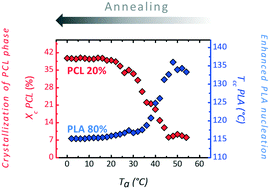Abstract
Accelerating the crystallization rate of polylactide (PLA) to extend its application range is an interesting challenge. In this work, the crystallization of PLA from the glassy state within 80/20 PLA/PCL blends, with or without the addition of three different compositions of poly(L-lactide-block-carbonate) (PLA-b-PC) diblock copolymers, is investigated. The samples were evaluated by SEM (Scanning Electron Microscopy), PLOM (Polarized Light Optical Microscopy) and DSC (Differential Scanning Calorimetry). The blends exhibit a sea-island morphology with PCL droplets finely dispersed in a PLA matrix. Adding PLA-b-PC copolymers reduces PCL droplet size. Upon using a 50/50 PLA-b-PC copolymer, a threefold particle size decrease was observed. At the same, the glass transition temperature of the PLA phase is depressed, as PLA-b-PC addition induces partial miscibility between PLA and PCL. Non-isothermal and isothermal DSC experiments demonstrate that PCL addition accelerates cold crystallization of PLA, even in neat PCL/PLA blends. However, the PLA spherulitic growth rate is insensitive to PCL addition; therefore, this acceleration is due to a remarkable nucleation effect that PCL droplets provoke on glassy PLA. By aging the blends below the Tg of PLA, the DSC results demonstrate that the crystallization of PCL droplets is responsible for the enhanced nucleation of the surrounding glassy PLA matrix. Such nuclei are activated at higher temperatures (at which PCL droplets are molten), when the sample is heated from the glassy state, and therefore PLA cold crystallization is accelerated. On the other hand, no significant nucleation effects for neat PLA/PCL blends are detected when PLA crystallization starts from the melt state.



 Please wait while we load your content...
Please wait while we load your content...